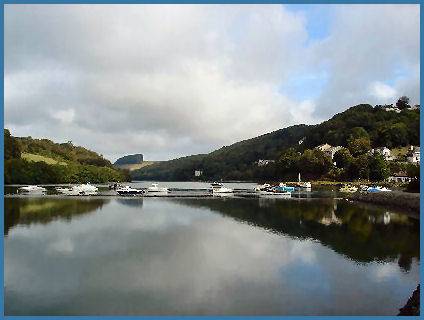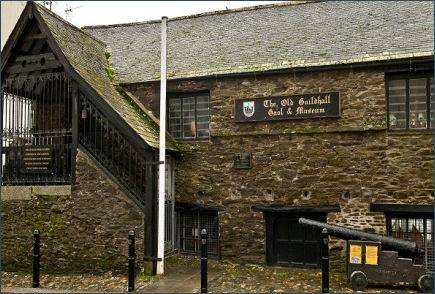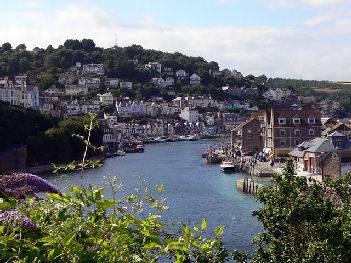Looe
OS grid ref:- SX254533
 East and West Looe, on Cornwall's south east coast are divided by a deep wooded river valley crossed by a seven arched bridge, which dates back to 1853.
East and West Looe, on Cornwall's south east coast are divided by a deep wooded river valley crossed by a seven arched bridge, which dates back to 1853.
Highly picturesque East Looe, which was granted its charter by King Edward III in 1237, is the larger and is an attractive little town. Bobbing fishing boats line its quay, the warehouses around the quay have been converted into holiday flats, restaurants and shops and boat trips are available to Mevagissey and Fowey.
In the eighteenth century, as well as serving as a fishing port, Looe was a copper port, exporting ore from the mines on Bodmin Moor. The bustling harbour remains at the hub of the town and home to over 60 commercial fishing vessels as well as pleasure and tripping boats.
The town consists of a warren of characterful narrow streets and offers a range of shops, pubs and accommodation, a beach and a golf course.Guided tours are available.
 East Looe has a beach beside the Banjo Pier, while West Looe has Hannafore Beach, Hannafore Beach stretches from Hannafore Point along Marine Drive and consists of two beaches, Hannafore Beach & Wallace Beach. It is predominantly a rocky beach
with shingle and patches of course sand at low tide.
East Looe has a beach beside the Banjo Pier, while West Looe has Hannafore Beach, Hannafore Beach stretches from Hannafore Point along Marine Drive and consists of two beaches, Hannafore Beach & Wallace Beach. It is predominantly a rocky beach
with shingle and patches of course sand at low tide.
From the beach there are views across to Looe Island, otherwise known as St. George's Island, which lies a mile off the coast and is now owned by Cornwall Wildlife Trust. The island, a one time haunt of smugglers, covers an area of 22.5 acres and is a sanctuary for sea birds. A Benedictine chapel was built on the island in 1139 of which only a few stones remain visible. The island has an extremely mild climate, daffodils there flower at Christmatime and is open to visitors during the summer (a landing fee is payable). At extremely very low spring tides, it can be reached on foot
The sixteenth century Old Guildhall (pictured right) houses a museum devoted to smuggling and fishing, and hold a collection of smuggling memorabilia, Looe's railway heritage and some wonderful model boats. Fishing, geology, tourism and the wars also features.(Open- Easter, May - Sept Sun - Fri 11.30am - 4.30pm) The magnificent magistrates bench, with the colourful Royal coat of arms above, is the focal point and dates from when the building was the town courtroom. The cells are to be found downstairs. The building formerly served as the town hall, the present town hall is the Victorian Guildhall in Fore Street.
Living from the Sea by the fish market has a shark museum (Open Easter - Oct, daily)
 The Monkey Sanctuary at Murrayton in Looe is home to a colony of woolly monkeys, the first place in the world to successfully breed
Amazon wooly monkeys, three generations have now been born at the sanctuary.The Monkey Sanctuary Trust is a unique environmental charity dedicated to promoting the welfare,
conservation and survival of primates and conserving natural habitats through education and sustainable living..
The Monkey Sanctuary at Murrayton in Looe is home to a colony of woolly monkeys, the first place in the world to successfully breed
Amazon wooly monkeys, three generations have now been born at the sanctuary.The Monkey Sanctuary Trust is a unique environmental charity dedicated to promoting the welfare,
conservation and survival of primates and conserving natural habitats through education and sustainable living..
Across the bridge in West Looe stands the fourteenth century Church of St. Nicholas which has in the past served as guildhall, prison and school and a 500 year old inn, the Jolly Sailor which serves meals.
Looe is famous for holding some of the best New Year celebrations in Britain. Revellers in fancy dress fill the streets, pubs and restaurants. At midnight a spectacular firework display takes place on the banjo pier.
The SE Cornwall Discovery Centre at Millpool has displays, exhibitions and video presentations on south-east Cornwall.
Nearby stands the Duloe Stone Circle (OS grid ref- SX 233 582) a prehistoric stone circle of white quartzite stones, at the village of Duloe.